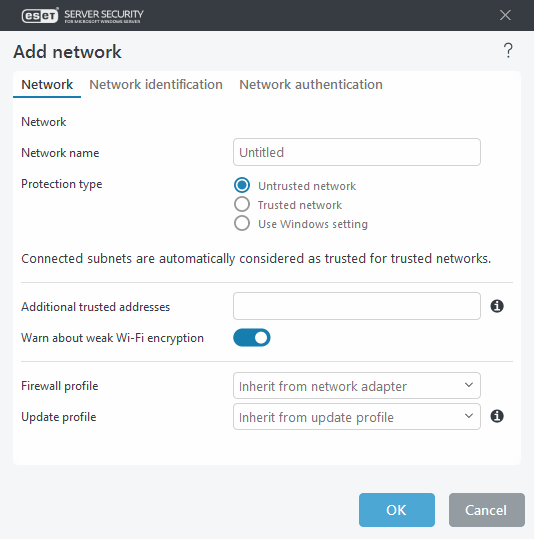Add network
Network configuration settings are arranged in the following tabs:
Network
You can define the Network name and select the Protection type for the network. Shows if the network is set to Trusted network, Untrusted network or Use Windows setting.
Additionally, addresses added under, Additional trusted addresses are always added to the trusted zone of adapters connected to this network (regardless of the network's protection type).
•Warn about weak WiFi encryption—ESET Mail Security will inform you when you connect to an unprotected wireless network or network with weak protection.
•Firewall profile will be inherited from the network adapter.
•Update profile—Select update profile that will be used when connected to this network.

Network identification
Is performed based on the local network adapter's parameters. All selected parameters are compared against the actual parameters of active network connections. IPv4 and IPv6 addresses are allowed.
Network authentication
Searches for a specific server in the network and uses asymmetric encryption (RSA) to authenticate that server. The name of the network being authenticated must match the zone name set in authentication server settings. The name is case sensitive. Specify a server name, server listening port and a public key that corresponds to the private server key. The server name can be entered in the form of an IP address, DNS or NetBios name and can be followed by a path specifying the location of the key on the server (for example, server_name_/directory1/directory2/authentication). You can specify alternate servers to use by appending them to the path, separated by semicolons.
The public key can be imported using any of the following file types:
•PEM encrypted public key (.pem), this key can be generated using the ESET Authentication Server.
•Encrypted public key
•Public key certificate (.crt)
Click Test to test your settings. If authentication is successful, Server authentication was successful will be displayed. If authentication is not configured properly, the following error messages will be displayed:
Server authentication failed. Invalid or mismatched signature. |
Server signature does not match the public key entered. |
|---|---|
Server authentication failed. Network name does not match. |
Deactivate this switch if you want to keep the rule in the list but do not want to use it. |
Server authentication failed. Invalid or no response from server. |
No response is received if the server is not running or is inaccessible. An invalid response may be received if another HTTP server is running on the specified address. |
Invalid public key entered. |
Verify that the public key file you have entered is not corrupted. |